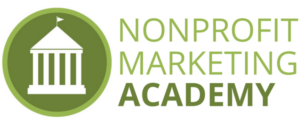One of the biggest mistakes marketers can make with nonprofit marketing is following a one-size-fits-all strategy. Yes, we are strapped for time. Many nonprofits are working with limited staff. Most are trying to do more with a limited budget. But even with those restrictions, if we don’t create the right kind of marketing, it’s a wasted effort.
 The one-size-fits-all strategy looks like this.
The one-size-fits-all strategy looks like this.
A nonprofit marketer creates an event flyer and on the flyer, you see a call for volunteers, sponsors, event attendees and maybe more.
We expect our viewers to decode the flyer and find where they fit in. As the marketer, we check-off the task of creating the flyer and feel like we’ve done our job.
But the truth is we have not done our job.
If you want a greater return on your nonprofit marketing efforts, then read on to learn an effective five-step strategy using Integrated Nonprofit Marketing and Fundraising.
Step 1: Divide and Conquer – Divide your nonprofit audiences into segments based on what you want them to do.
On average, with our content, we can keep a person’s attention for about six seconds. Then, if the content we are sharing doesn’t apply to them, they will move on to other content. This statistic alone drives home the importance of segmenting our nonprofit audiences and create messaging that relates to them.
Think about your different audiences… What is important to a business sponsor will not resonate with a volunteer. The same goes for the people who would be interested in attending your fundraising event or joining your program or services. They have different reasons for going to the event than those who want to volunteer.
So, begin with identifying who are you trying to reach and why?
-
- Sponsors – We want businesses to support our events and programs.
- Volunteers – We need community residents to help us organize the event and help during and after the event.
- Attendees – We need people to buy tickets to the event. We need them to stay connected after the event.
Step 2: Answer the question What’s In It For Me – Tell your audiences what they will get for supporting the event.
Once you have segmented your audience, it’s now time to write a message that tells each segment what they will get out of the event. Listed below are the audience segments and a few examples of the type of information that is important to each segment.
-
- Sponsors – Audience reach, number of promotional opportunities, opportunities to interact with the event audience, opportunities to capture leads, opportunities to demonstrate their products.
- Volunteers – Hours and shifts available, how the volunteer program is organized, the types of activities available, gifts and recognition.
- Attendees – Networking opportunities, time with friends or family, cost of tickets, activities at the event, location of event, venue, number of people who attend, types of entertainment.
Step 3: Create and customize the type of content each audience needs and wants.
The list of possibilities for content is endless. There are more choices than we can imagine. Begin by identifying what resonates best with the audience segment you are trying to reach. Is it social media, an email, or a flyer? Is it an image, a video, or an infographic? In step three, identify the types of content that will work best for each audience segment.
Step 4: Use content heroes, outcomes, and a clear ‘call to action.’
Step four engages what is called mission-focused content. There are three components to mission-focused content:
-
- Content hero – People who are engaged with your nonprofit and/or are important to the audience. This includes audience influencers, nonprofit staff, nonprofit clients, volunteers, sponsors, event participants, guest speakers, etc.
- Outcomes – The performance outcomes of your nonprofit or the impact made on the community. Or the outcome of the event (the WIIFM for the audience).
- Call to Action – What do you want this audience to do? Go to a landing page and register, click and donate, take a poll, save the date, invite friends? Give them one action to take.

Step 5: Monitor, Measure and Manage Content
Track the engagement and outcomes for each audience segment and each form of content.
What is performing the best?
What content is producing the most action on the calls to action?
What content is performing the worst and why is that?
For content that is not performing well, determine if it was the delivery mechanism or the timing that affected the performance. How many people actually saw the content? The content itself may be sufficient but other factors may be affecting performance and ROI.
In this step, tweak the marketing efforts so that you are creating more high performing content and are using what works.
Take your nonprofit marketing and fundraising to a new level with audience-focused events, board-focused fundraising, and mission-focused content. Learn a process for each in this free, on-demand training.
This training is designed for any nonprofit organization wanting to engage the entire team in marketing and fundraising. Leverage the resources you already have to grow your ideal audiences, make a greater impact and increase revenue.





